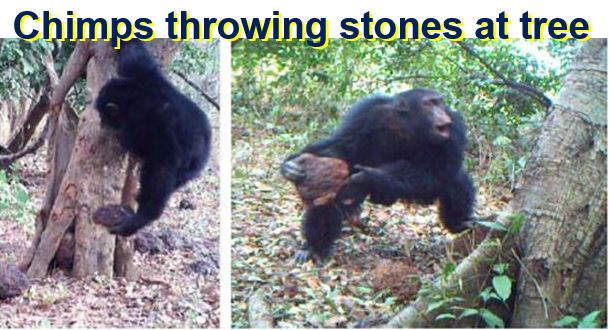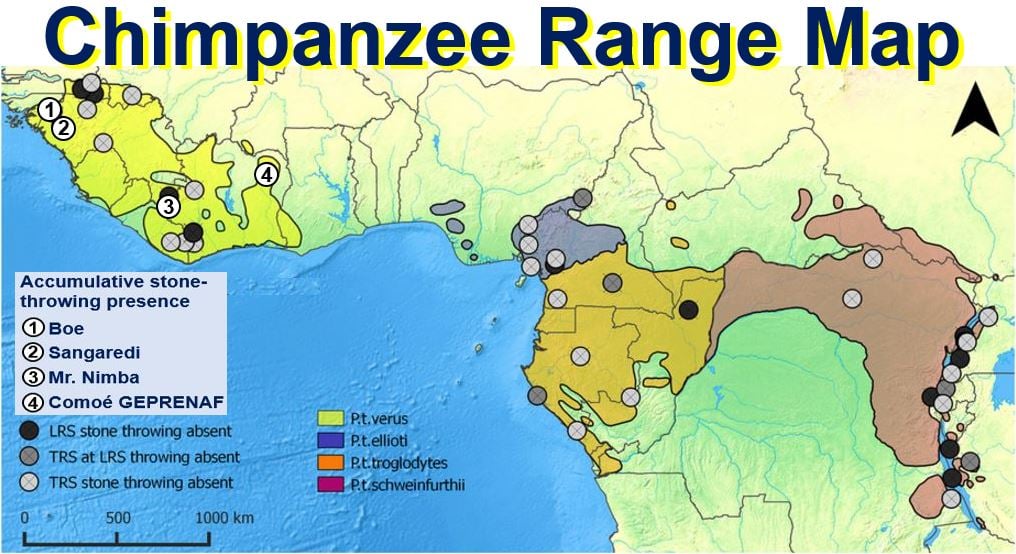Imagine a group of chimps going up to a tree, staring at it, throwing stones at it, and making small piles of stones (cairns) at the base of the trunk. A team of zoologists, evolutionary anthropologists and animal psychologists witnessed these extraordinary ritualistic actions, and wondered whether chimps share the human trait of idol or God worship.
Could chimpanzees be much closer to us in the evolutionary ladder than we realised? Some readers have suggested that perhaps, for reasons unknown, they are catching up with us, while others who watched the video (bottom of page) wondered whether the animals might be doing a basket-ball-type target practice.
We know that chimpanzees use tools to consume or extract food. Which tools they select and what for, however, can vary depending on the region where they live.
 These enigmatic stone piles under trees are the work of chimpanzees? Is it part of some kind of ritual, or could it be target practice? (Image: mpg.de)
These enigmatic stone piles under trees are the work of chimpanzees? Is it part of some kind of ritual, or could it be target practice? (Image: mpg.de)
Scientists wrote about this fascinating chimp ‘ritual’ in the prestigious journal Scientific Reports, a Nature publication.
Researchers at the Max Planck Institute for Evolutionary Anthropology in Leipzig, Germany, established the Pan African Programme: The Cultured Chimpanzee, and have been gathering data on chimp behaviour, demography and resource availability across Africa since 2010.
Behaviour may have some cultural elements
It was during activities within the Programme that researchers witnessed these hitherto unseen behaviours, which appear to have nothing to do with foraging (getting food).
Experts have no idea why the animals were doing this. They said the behaviour appeared to have some cultural elements.
Chimpanzees have been extensively studied for nearly sixty years at a few long-term field sites, most of them in West and East Africa.
 (Left) An adult male chimp tossing a stone, (Right) hurling a stone in Boé, Guinea-Bissau. (nature.com)
(Left) An adult male chimp tossing a stone, (Right) hurling a stone in Boé, Guinea-Bissau. (nature.com)
Chimps are proficient users of tools for fishing, getting at termites, scooping out ants, and extracting honey. They have even been seen using wooden or stone hammers to crack open nuts.
Outside the foraging context, sometimes male chimps throw stones and branches about during displays, or leaf-clip as a way of telling females they want to mate.
The field studies carried out at different reserves and centres have been fundamental for providing a good understanding of natural chimpanzee behaviour, and most importantly, the differences between various populations.
In order to gain a better understanding of the ecological and evolutionary drivers of behavioral diversification in chimpanzees, the Department of Primatology at the Max Planck Institute for Evolutionary Anthropology established the ‘Pan African Programme: The Cultured Chimpanzee’ (PanAf).
Hjalmar Kuehl, who works at the Max Planck Institute for Evolutionary Anthropology and the German Centre for Integrative Biodiversity Research, said:
“The PanAf project represents a new approach to studying chimpanzees and will provide many interesting insights into chimpanzee demography and social structure, genetics, behavior and culture.”
“The Pan Af is only possible due to the numerous collaborations with chimpanzee researchers, field workers and national wildlife authorities in 14 countries across Africa.”
As the animals were not used to having humans present at these sites, the scientists used a wide range of non-invasive sampling methods, including remote camera traps.
 The map shows the locations of the chimpanzee populations studied across West Africa. Stone-throwing was videoed in four of them. (Image: nature.com)
The map shows the locations of the chimpanzee populations studied across West Africa. Stone-throwing was videoed in four of them. (Image: nature.com)
Cameras reveal origin of stone piles
The field teams discovered conspicuous piles of stones at the base of trees at four West African research sites. They placed camera traps next to each one.
At the Chimbo Foundation in Guinea Bissau, the researchers saw some impressive video footages which confirmed what they had been suspecting – the chimpanzees were responsible for these piles of stones. They were regularly visiting the trees.
Ammie Kalan, who works at the Max Planck Institute for Evolutionary Anthropology, said:
“The PanAf cameras filmed individual chimpanzees picking up stones from beside, or inside trees, and then throwing them at these trees while emitting a long-distance pant hoot vocalization.”
Most of the ritualistic behaviours that led to the creation of the piles of stones were being done by the males. However, the camera traps also recorded cases of females and juveniles doing the same.
Behaviour not linked to foraging
Nobody in West Africa had ever seen this kind of behaviour before. They were not doing this in order to get at food, the researchers said.
Christophe Boesch, director of the Department of Primatology at the Max Planck Institute for Evolutionary Anthropology, said:
“This study reports a new chimpanzee behavior not known previously and highlights the potential of the PanAf project to uncover unknown facets of the life of chimpanzees, our closest living relative.”
“As the stone accumulation behavior does not seem to be linked to either the abundance of stones or the availability of suitable trees in an area, it is likely that it has some cultural elements.”
Do modern chimps reflect early human behaviour?
Chimps are often used as a model for the evolution of our ancient ancestors (hominins). After discovering these conspicuous piles of stones linked to their newly discovered behaviours, the researchers wonder whether we could gain any insights into how stone accumulations in archaeological sites were built.
Could modern chimpanzees’ ritualistic behaviours shed some light on the origin of ritual sites in hominin evolution? The authors think so.
The PanAF videos and other data are currently being analyzed. The scientists invite members of the public to participate in interpreting chimp behaviour by watching the PanAf videos online at www.chimpandsee.org, which has more than 1 million video clips. Visit the website to see how you could become a citizen scientist!
Citation: “Chimpanzee accumulative stone throwing,” Hjalmar S. Kühl, Ammie K. Kalan, Christophe Boesch et al. Scientific Reports. 29 February, 2016. DOI: 10.1038/srep22219.
Video – Chimpanzee throwing a stone at a tree
